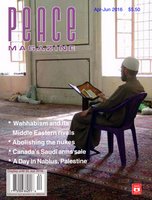
Peace Magazine Apr-Jun 2016, page 2. Some rights reserved.
The legendary activist Berta Caceres was assassinated on March 3 in her hometown, La Esperanza, Honduras. Her friends unequivocally blame the murder on death squads acting for the Honduran government—a response to Caceres’s recent partial success in stopping a hydro-electric project.
An anti-mining activist, Gustavo Castro Soto, had been staying in her home to provide accompaniment in the hope of preventing precisely such an attack; he was shot twice but feigned death and survived. Caceres died in his arms. Castro Soto himself was held for “questioning” and not allowed to leave the country. He still faces risk, as noted in his message to his group: “Hit men already know that I did not die and surely they want to complete their task.”
Central American activists now all fear for their lives, since these two shootings were far from unique. On March 15, Nelson Garcia, another member of Caceres’s organization, the Civil Council of Grassroots and Indigenous Organization of Honduras (COPINH), was also assassinated.
The hydro project that COPINH opposes had been imposed on the community without consultation. Berta Caceres blamed the US and multinational corporations for the detrimental environmental effects.
In June 2009 the Honduran military had seized the democratically elected President Manuel Zelaya and flown him out of the country. Fifteen House Democrats wrote to Obama asking the State Department to admit that a military coup had taken place and to suspend non-humanitarian aid, as US law required.
However, Secretary of State Hillary Clinton refused to do so. Her memoir, Hard Choices, disclosed her strategy for avoiding this. (The subsequent paperback edition of that book deleted mention of the Honduran matter.) The US State Department blocked the Organization of American States from adopting a resolution that would have refused to recognize the elections that the new dictatorship quickly held, in accordance with Ms. Clinton’s plan. That regime is still in power and repressing indigenous activists. Mainstream US news media do not mention American responsibility for this situation.
Sources: Jeff Abbott, Truthout March 18, 2016; Beverly Bell, Foreign Policy in Focus.
Anti-nuclear power activists in Japan, Canada, and the US are drawing support from some government officials to oppose the decisions made by other governing authorities.
Japan’s 54 nuclear reactors were all shut down for about three years, mainly because wary local citizens, distressed by the Fukushima tragedy, refused to consent to the government’s plans.
In January two of the power plants, each having two reactors, were restarted. However, on March 9, only two months after resuming operations, one of those plants—the Takahama Nuclear Power Plant—was again closed by court order. The judge stated that neither restart should have happened.
Government safety regulators claim that the Takahama plant meets Japan’s new safety rules, but the court agreed with the plaintiffs, stating that accident prevention remains a realistic worry.
In North America, the US and Canada had agreed to a new plan that worries citizens—the transport of vast quantities of radioactive liquid waste that has been kept, until now, in storage tanks at Ontario’s Chalk River plant.
When irradiated uranium is dissolved in nitric acid, the product is a highly radioactive liquid containing such by-products as neptunium, plutonium, americium, and curium. The concentration of cesium 137 in this liquid is four times higher than that in the tanks at the military plutonium production plants at Hanford, Washington. It is one of the world’s most dangerous substances .
But what to do with it? The Chalk River Laboratories have invented a process of “cementation” to turn this liquid into a solid. For the past ten years, this has been done successfully, turning it into “cement” that is kept on-site.
However, both Canada and the US have a plan to transport the liquid material over public roads from Chalk River to Savannah, South Carolina. Over 100 truckloads would be sent about 2,000 kilometers over secret routes through Ontario and western New York, accompanied by heavily-armed guards. No such thing has ever been done before, and no public hearings have been held to examine the health, security, or environmental risks.
Although there have been protests from Canadian anti-nuclear power activists, the most powerful opposition seems to be American. Congressman Brian Higgins, D-NY-26, is objecting to the plan. He points to an incident that occurred on October 28 at Chalk River, when cracks in the weld of several fuel caddies were discovered, but not reported to Canadian or US oversight agencies in a timely manner. The company that was responsible for those casks is the same one that would produce the casks for the trip. Higgins wants such shipments to be kept out of his state.
Source: Gordon Edwards, a critic of Canada’s nuclear industry.